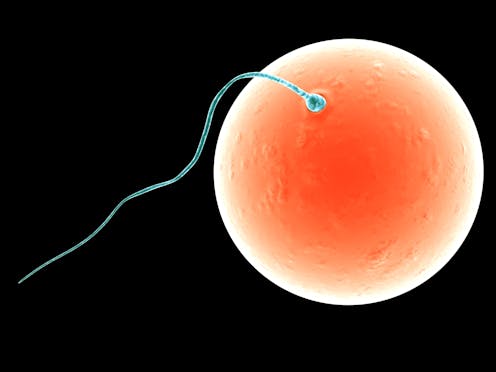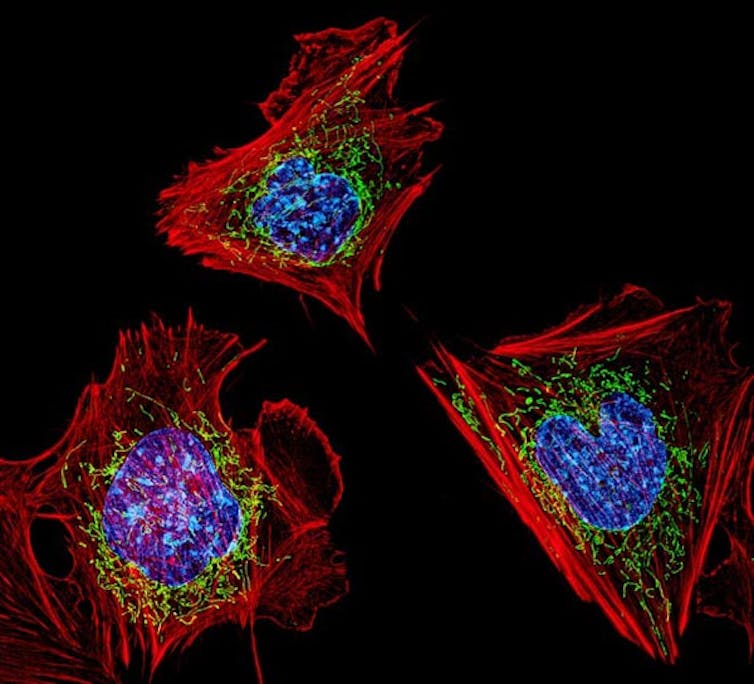It's mostly mothers who pass on mitochondria – and a new theory says it's due to the first sexual co
An ancient sexual conflict over mitochondrial inheritance may be responsible for the evolution of the two sexes as we know them.

Evolutionary interests of males and females do not always coincide. This is known as sexual conflict: male innovations that allow them to reproduce more sometimes hurt females, and vice versa.
Male fruit flies, for instance, inject their partners with toxic chemicals during sex. These toxins destroy sperm of the female’s previous mates, improving his own chances for becoming the sole father of her offspring. But the toxins also make female flies sick and reduce their lifespan. Females, in turn, have evolved defenses to counter the chemicals, sometimes at the expense of males’ success.
Biologists believe that sexual conflicts are rooted in the size and number of reproductive cells – eggs and sperm. Males typically produce large numbers of sperm that can fertilize multiple eggs. Females, on the other hand, produce a small number of large reproductive cells, and so invest more energy and resources in each.
My team of evolutionary biologists at University College London has now identified a different kind of sexual conflict, dating back to the days when the most complex organisms were made of single cells, possibly as far as 1.5 billion years ago. This ancient sexual conflict – before the two sexes even existed – had to do with whose mitochondria would be passed on to offspring.

Whose mitochondria will be passed on?
We studied inheritance of genes located in mitochondria – the structures inside our cells that breathe and produce energy. In many animals and plants, when the egg is fertilized, only the mother’s mitochondrial genes survive, while the father’s mitochondria are lost.
This is not by accident: Females have evolved many mechanisms to recognize a partner’s mitochondria entering the egg. Once detected, an army of enzymes is sent to digest them. Previous research has shown that getting rid of male mitochondria is a way to keep descendents’ mitochondrial genes mutation-free. In the long run, inheritance of healthy maternal mitochondria is good news for the offspring.

But there are many exceptions that remain unexplained. In some species, paternal mitochondria remain undigested, as if the father had found a way to protect them from being detected. Stranger still, in organisms such as fruit flies and many plants, it is the father that destroys most of his own mitochondria during production of sperm.
If maternal inheritance is as beneficial as previous research shows, why are there so many exceptions?
Taking the long or the short view
In our new study, we show that these exceptions arise because of a sexual conflict over the control of mitochondrial inheritance.
Using mathematical modeling, we found that evolution in females tends to focus on long-term effects. Destroying paternal mitochondria makes it easier to weed out harmful mutations in the future, but this effect unfolds over many generations. This strategy works well in females, because the same healthy set of maternal mitochondria is passed down the female line over and over again.
But males don’t have a long evolutionary time horizon to deal with in this case. Since most of their mitochondria are replaced by maternal ones at the start of every generation, evolution cannot detect long-term benefits from males’ mitochondrial genes. Because there’s no long-term link, they can benefit only in the immediate future, and that often means passing on some of their mitochondria right now. Males therefore seek to improve the fitness of their offspring in the short-term, even if the long-term effects are harmful.
It’s these different interests of males and females that can lead to an evolutionary arms race, as selection in the two sexes acts in opposite directions. Evolution in females strives to keep the future generations free of male mitochondria, while males make every effort to get some of theirs into the mix.
“Over and over again, males have come up with ways to subvert female destruction of their mitochondria,” said my co-author, geneticist Andrew Pomiankowski. “So females had to develop new ways to block male mitochondria. Our model explains nicely why there are so many different mechanisms used to exclude male mitochondria, and why males sometimes do it themselves.”
It’s all about the control of mitochondrial inheritance – and for males it’s better to be in the driver’s seat to decide how many mitochondria they contribute to the mix than be completely excluded.
A sexual conflict that led to the sexes
There is evidence that this conflict dates back to the days when all organisms were made of single cells. Male and female sexes did not exist, because all reproductive cells were of the same size.
“One of the strategies an organism can use to win in this conflict is to simply have more mitochondria than their partner, for example, by increasing the size of their sex cells,” Andrew Pomiankowski said. “Strikingly, this might have been the impetus to evolve two sexes in the first place.” Larger sex cells – the future eggs – garnered an advantage in the battle over mitochondrial inheritance, simply by swamping smaller sex cells – the forerunners of sperm – that had fewer mitochondria to contribute.
Most biologists currently think that two sexes evolved through division of labor – a so-called “disruptive selection” theory. Large female sex cells can survive longer but cannot move much, while smaller sperm are fragile but move faster and can find more mating partners.
Our hypothesis on the origin of sexes, if true, adds a new angle to this origins story, tracing it back to an ancient conflict over mitochondrial inheritance. Females may have won this ancient battle by simply producing larger sex cells packed with mitochondria, ensuring that mitochondrial transmission is effectively one-sided (and reaping the long-term fitness benefits). But ultimately, as with all scientific hypotheses, this one will have to stand the test of thorough experimental verification.
Arunas L Radzvilavicius receives funding from David and Lucille Packard Foundation.
Read These Next
Billionaires with $1 salaries – and other legal tax dodges the ultrawealthy use to keep their riches
The richest Americans can largely avoid paying income and other taxes. A new book explains the history.
Rising electricity prices and an aging grid challenge the nation as data centers demand more power
Energy projects are expensive and take a long time to build. Where to build them is often also a difficult,…
The #iwasfifteen hashtag and ongoing Epstein coverage show how traffickers exploit the vulnerabiliti
The conversation around #iwasfifteen sheds light on the dynamics of abusive relationships and the experiences…






